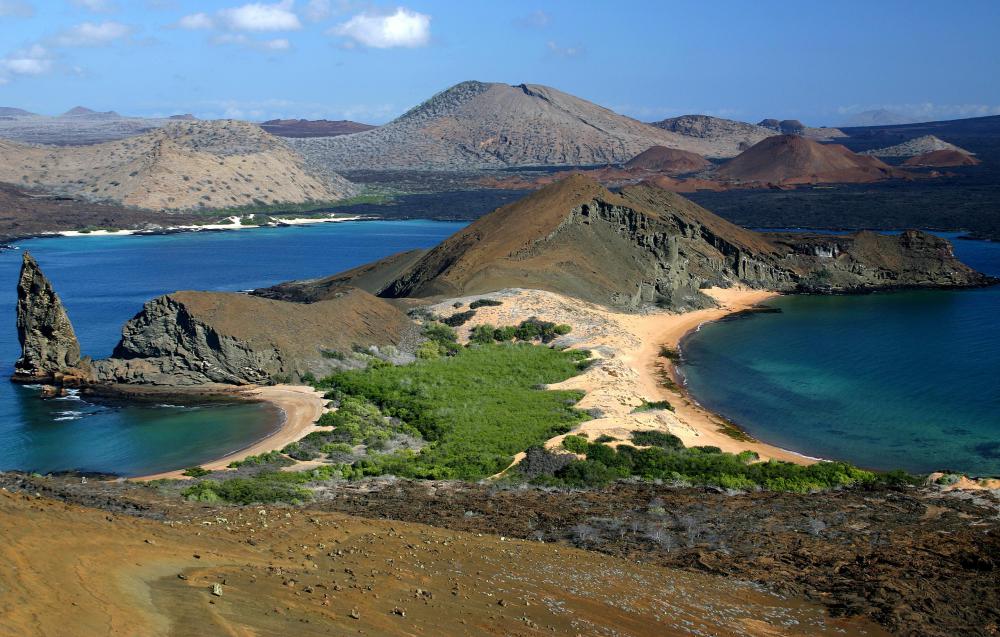At AllThingsNature, we're committed to delivering accurate, trustworthy information. Our expert-authored content is rigorously fact-checked and sourced from credible authorities. Discover how we uphold the highest standards in providing you with reliable knowledge.
What is an Archipelago?
An archipelago is a cluster of islands frequently formed by volcanic activity. Examples can be found in the open sea as well as close to large land masses. The former is usually more common than the latter.
In some cases, an archipelago forms because it is above an ocean hotspot. There are about 50 identified hotspots that are defined as having an extended period of active volcanism. One famous cluster is the Hawaiian Islands, which sits atop an ocean hotspot.

Both erosion and sediment deposits can influence how an archipelago forms. For example, when the islands occur near a larger land mass, they may have formerly been connected to that mass. Both erosion and shifting of tectonic plates may have resulted in parts of the land mass drifting away or being separated. This is generally a very lengthy process.

Due to volcanic activity, islands in an archipelago may either reduce or increase in size. If volcanic activity remains fairly constant, deposition of volcanic materials may actually expand an island. Since the island is surrounded by water, it is also subject to relatively continuous erosion. Fierce volcanic activity can completely decimate an island in an archipelago, too. Climate can certainly have an effect on the islands as well. Those located in tropical regions are subject to fierce hurricanes.

There are many archipelagos in the world, and the definition can refer not only to a group of islands, but also any sea that has a number of small islands. The Aegean Sea is considered an archipelago because of its many land masses. An island group doesn’t necessarily have to be small, nor is it always unstable. The British Isles, for example, are a large and stable cluster, and the Florida Keys includes at least 1,700 small islands extending from the southern tip of Florida. Another large archipelago is the islands that make up New Zealand and New Guinea.
Frequently Asked Questions
What is an archipelago?

An archipelago is a chain or cluster of islands that are formed close to each other in a body of water, often the ocean. These islands can be formed through volcanic activity, erosion, or the rising and falling of sea levels. Archipelagos can vary greatly in size and number of islands, from just a few to thousands.
How are archipelagos formed?
Archipelagos can be formed through various geological processes. Volcanic archipelagos, like the Hawaiian Islands, are created by underwater volcanic eruptions. Others form when a single landmass breaks apart due to tectonic activity, as seen in the case of the Philippines. Sea-level changes can also expose the tops of submerged mountains, forming island chains.
What are some examples of archipelagos?

Notable examples of archipelagos include the Galápagos Islands, known for their unique wildlife and Charles Darwin's studies; the Greek Islands, steeped in history and culture; and Indonesia, which is the world's largest archipelago with over 17,000 islands, according to the Indonesian Coordinating Ministry for Maritime Affairs.
Can archipelagos be inhabited?
Yes, many archipelagos are inhabited, with communities that have adapted to the maritime environment. Inhabited archipelagos often have rich cultural heritages, with livelihoods typically revolving around fishing, maritime trade, and tourism. The population density and development can vary widely from one archipelago to another.
What is the significance of archipelagos to biodiversity?
Archipelagos are hotspots for biodiversity due to their isolation, which leads to the evolution of unique species. The Galápagos Islands, for instance, are home to species found nowhere else on Earth. This isolation can also make archipelago ecosystems vulnerable to changes, emphasizing the importance of conservation efforts.
How does climate change affect archipelagos?
Climate change poses a significant threat to archipelagos, particularly through rising sea levels and increased storm intensity. Low-lying islands may face submersion, while changes in sea temperature and acidity can disrupt marine life. The Intergovernmental Panel on Climate Change (IPCC) provides ongoing assessments of these risks to island nations and ecosystems.
AS FEATURED ON:
AS FEATURED ON:















Discussion Comments
What is the climate of an archipelago?
where is greece's archipelago?
Some archipelagos form near continental landmasses because of the way that the earth's tectonic plates work. In subduction zones, water flows underneath the continental plate with the oceanic plate, superheating the subducting rock and creating magma. This magma flows up to the surface within a few hundred miles or less of the continental plate, forming archipelagos that follow the shape of the plate boundaries. The Aleutian Islands, and other island chains in the North Pacific and around the ring of fire, are perfect examples of this process in action.
@ Anon91648- The Philippines are an archipelago because they are a string of islands that make up an island nation. The Philippines are on the southwestern edge of the ring of fire, the volcanically active ring that surrounds the Pacific plate.
Because they are a chain of islands off the country of china.
why is the Philippines called an archipelago?
Post your comments